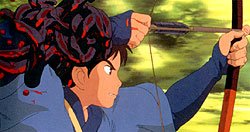 The quiet stillness of the forest is broken by a sound... a sound, not native to the trees of this forest. It comes closer and closer to the village of a small clan of defeated warriors, the Emishi. A large red elk breaks through the trees, its companion sitting proudly erect on its back. Something is wrong... Deadly wrong. The quiet stillness of the forest is broken by a sound... a sound, not native to the trees of this forest. It comes closer and closer to the village of a small clan of defeated warriors, the Emishi. A large red elk breaks through the trees, its companion sitting proudly erect on its back. Something is wrong... Deadly wrong.
And so begins the tale.
Fantasy and fable in Japanese animation isn't a new concept. It's been used repeatedly by many anime creators to help weave a tale of a simpler time. The time when technology as we know it didn't exist. A time when civilization was finally coming to be a dominant force in the world. A time when the world around us screamed in agony as the effects of man forever scarred the living landscape, never to be the same. It's a time when knights and sorcerers ruled the land. A time when myth and legend held more reality than reality itself. And in Japan, it was a time when the Samurai held fast to its control over the Japanese people.
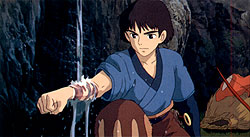 Those times long past have always called to the heart of the human spirit. They help us think back to that simpler time. In anime, there are plenty of reminders of that time. Director and storyteller Shouji Kawamori introduced us to a new world in The Vision of Escaflowne, where knights fought bravely to defend good or evil. Sorcery and magic took us on the adventure through a cursed land ravaged by evil in Record of Lodoss War. But no one in the history of anime has shown the true struggle in those fantasy worlds better then Hayao Miyazaki. Those times long past have always called to the heart of the human spirit. They help us think back to that simpler time. In anime, there are plenty of reminders of that time. Director and storyteller Shouji Kawamori introduced us to a new world in The Vision of Escaflowne, where knights fought bravely to defend good or evil. Sorcery and magic took us on the adventure through a cursed land ravaged by evil in Record of Lodoss War. But no one in the history of anime has shown the true struggle in those fantasy worlds better then Hayao Miyazaki.
Miyazaki has taken the fantasy anime tale to a level never before attained by any anime creator. He was always on the cutting edge of storytelling innovation, always willing to leave the stereotypical anime story behind and present us with something that would make you think and look inside yourself. He presents no answers, but definitely provides us all with questions that don't necessarily have any set solutions. He effectively shows us how something as simple as respect for the environment is a concept that transcends time. It is those timeless concepts that make Miyazaki's films more than just typical anime.
 The use of mythology and fantasy has been a recurring theme in Miyazaki-san's work and can be seen through the works of Studio Ghibli, the animation studio he had founded with fellow director Takahata Isao and publishing company Tokuma Shoten. Yet another theme found in Ghibli films is the never-ending battle between man and the environment around us, a battle, it seems, neither side will win. This is the basis for the film that brought in over $150 million at the Japanese box offices and is the highest grossing domestic Japanese motion picture of all time, Mononoke Hime. The use of mythology and fantasy has been a recurring theme in Miyazaki-san's work and can be seen through the works of Studio Ghibli, the animation studio he had founded with fellow director Takahata Isao and publishing company Tokuma Shoten. Yet another theme found in Ghibli films is the never-ending battle between man and the environment around us, a battle, it seems, neither side will win. This is the basis for the film that brought in over $150 million at the Japanese box offices and is the highest grossing domestic Japanese motion picture of all time, Mononoke Hime.
Storylines
Mononoke Hime is the story of a war between the expanding civilization of man and the giant beast-gods of the forest which threatens to destroy the delicate balance of the forces of nature. Set in the time of the Muromachi era, around the 15th century, Mononoke Hime takes place in a time of great chaos and change in Japan. This was a time when there were no distinctions between peasants and samurai, when women were bolder and freer, and when the lines between life and death were more clear-cut.
 The story begins in the remote village of the Emishi, a clan of warriors that had been driven to Northern Japan by the forces of the Yamato rulers of Japan in the latter part of the 14th century. Ashitaka, the last prince and warrior of the dying Emishi clan, is forced to kill a gigantic demon-monster that threatens his village. The villagers discover that the monster was actually a giant boar, a protector-god of the forest. In killing the god-turned-demon, Ashitaka has brought upon himself a curse, a dark, twisted scar on his right arm that is slowly spreading and will eventually kill him. The story begins in the remote village of the Emishi, a clan of warriors that had been driven to Northern Japan by the forces of the Yamato rulers of Japan in the latter part of the 14th century. Ashitaka, the last prince and warrior of the dying Emishi clan, is forced to kill a gigantic demon-monster that threatens his village. The villagers discover that the monster was actually a giant boar, a protector-god of the forest. In killing the god-turned-demon, Ashitaka has brought upon himself a curse, a dark, twisted scar on his right arm that is slowly spreading and will eventually kill him.
Ashitaka is told that he should go to the West Country to find out what caused the boar-god to turn into a demon and to search for a cure to his curse. He leaves the village with his riding companion, a red elk named Yakkuru, never to return. During his journey, he meets many people. The first is Jigo Bo, a fast-talking monk with an external agenda that helps Ashitaka and tells him of the legend of the Forest Spirit.
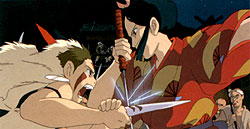 Taking Jigo's tale to heart, Ashitaka continues on until his path leads him to the Forest of the Deer God, a mystical region that is protected by the giant beast-gods. There he is thrust into the middle of a never-ending battle between man and nature. He first encounters the forest's Wolf Clan, Moro, a giant wolf-god that is sworn to protect the forest and the Deer God. He also sees San, the Princess Mononoke, a human girl that has been raised by the wolves. Later he ends up in the industrial city-fortress, Iron Town, where he meets Lady Eboshi and the Tatara Clan. The inhabitants of Iron Town, an odd assortment of hunters, lepers, prostitutes and outcasts, are on the edge of the wilderness fighting for their very existence by making iron from the ore in the mountains surrounding the town. Ashitaka gets a first hand view of both sides of the struggle and tries desperately to find a way to end the fighting and hatred on both sides and still keep the balance between man and nature. Taking Jigo's tale to heart, Ashitaka continues on until his path leads him to the Forest of the Deer God, a mystical region that is protected by the giant beast-gods. There he is thrust into the middle of a never-ending battle between man and nature. He first encounters the forest's Wolf Clan, Moro, a giant wolf-god that is sworn to protect the forest and the Deer God. He also sees San, the Princess Mononoke, a human girl that has been raised by the wolves. Later he ends up in the industrial city-fortress, Iron Town, where he meets Lady Eboshi and the Tatara Clan. The inhabitants of Iron Town, an odd assortment of hunters, lepers, prostitutes and outcasts, are on the edge of the wilderness fighting for their very existence by making iron from the ore in the mountains surrounding the town. Ashitaka gets a first hand view of both sides of the struggle and tries desperately to find a way to end the fighting and hatred on both sides and still keep the balance between man and nature.
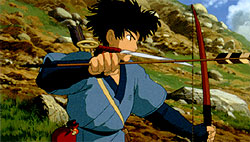 Take that scenario and throw in a bunch of samurai, a big pile of wild boars, arrows whizzing wildly through the air and some extraordinary special effects and visuals and you get a timeless epic that causes the viewer to take a step back and think about what they had just seen. The film shows that there is opposition in all things, including inside ourselves. It shows us that despite all the hatred and fighting in that remote area of Miyazaki-san's 15th century Japan, that the same scene still continues today and that there is a way to preserve both sides. That's the key feature to the story of Mononoke Hime. We all are left with the final solution. Take that scenario and throw in a bunch of samurai, a big pile of wild boars, arrows whizzing wildly through the air and some extraordinary special effects and visuals and you get a timeless epic that causes the viewer to take a step back and think about what they had just seen. The film shows that there is opposition in all things, including inside ourselves. It shows us that despite all the hatred and fighting in that remote area of Miyazaki-san's 15th century Japan, that the same scene still continues today and that there is a way to preserve both sides. That's the key feature to the story of Mononoke Hime. We all are left with the final solution.
Mononoke hits the US
On October 29, 1999, Princess Mononoke made its first official U.S. appearance on the big screen in the first set of selected theaters. The film was masterfully adapted and redubbed by the crew from Miramax Films. Renowned comic book creator Neil Gaiman was commissioned to write the adapted screenplay with Mononoke director/writer Hayao Miyazaki. Then an impressive cast was assembled to bring life to the characters for the release. The cast includes:
|
Billy Crudup as Ashitaka
|
|
Billy Bob Thornton as Jigo
|
|
Minnie Driver as Lady Eboshi
|
|
Gillian Anderson as Moro
|
|
Claire Danes as San
|
|
Jada Pinkett-Smith as Toki
|
|
Keith David as Okkoto
|
|
John Di Maggio as Gonza
|
|
John De Mita as Kohroku
|
Princess Mononoke is currently in select theaters around the country. For more information on the U.S. release, check out the official Princess Mononoke website at http://www.princess-mononoke.com/. There you'll find comments, pictures, theater listings and much more. Be sure to check it out! Also, check back next issue for a review of the US release.
In the End
Miyazaki-san himself summed up the meaning of Mononoke Hime the best. "Here lies, I believe, the meaning of making such a film as we enter the chaotic times of the twenty-first century. We are not trying to solve global problems with this film. There can be no happy ending to the war between the rampaging forest gods and humanity. But even in the midst of hatred and slaughter, there is still much to live for. Wonderful encounters and beautiful things still exist.
"We depict hatred in this film, but only to show that there are more important things. We depict a curse, but only to show the joy of deliverance. Most important of all, we show how a boy and a girl come to understand each other and how the girl opens her heart to the boy. At the end, the girl says to the boy, 'I love you, Ashitaka, but I cannot forgive human beings.' The boy smiles and says, 'That's all right. Let's live together in peace.'"

|
|
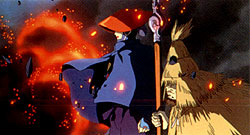
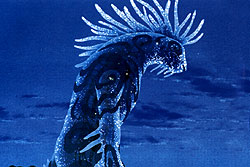
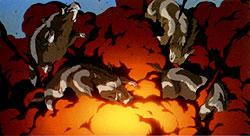

For more info on Mononoke Hime or any of the Studio Ghibli films, check out Nausicaa.net at http://www.nausicaa.net/.
 Or pick up the book PRINCESS MONONOKE: The Art and Making of Japan's Most Popular Film of All Time from Hyperion Books. Or pick up the book PRINCESS MONONOKE: The Art and Making of Japan's Most Popular Film of All Time from Hyperion Books.
ISBN # 0-7868-6609-8
Princess Mononke Character Guide |
|
